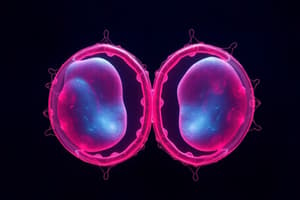Podcast
Questions and Answers
What is Meiosis?
What is Meiosis?
A specialized type of cell division that reduces the chromosome number by half.
What happens during Prophase?
What happens during Prophase?
The chromosomes become visible as paired chromatids and the nuclear envelope disappears.
What occurs during Metaphase?
What occurs during Metaphase?
The chromosomes become attached to the spindle fibers.
What is Anaphase?
What is Anaphase?
Describe Telophase.
Describe Telophase.
What is Cytokinesis?
What is Cytokinesis?
What happens during Prophase 2?
What happens during Prophase 2?
What occurs in Metaphase 2?
What occurs in Metaphase 2?
Describe Anaphase 2.
Describe Anaphase 2.
What is Telophase 2?
What is Telophase 2?
How does Cytokinesis occur during meiosis?
How does Cytokinesis occur during meiosis?
What is the difference between Meiosis 1 and Meiosis 2?
What is the difference between Meiosis 1 and Meiosis 2?
What is produced through Meiosis?
What is produced through Meiosis?
The chromosome pair XX represents a female.
The chromosome pair XX represents a female.
The chromosome pair XY represents a male.
The chromosome pair XY represents a male.
Flashcards are hidden until you start studying
Study Notes
Meiosis Overview
- Meiosis is a specialized cell division that halves the chromosome number.
- It occurs in two stages: meiosis I and meiosis II.
Meiosis I
- Prophase I: Chromosomes become visible as paired chromatids; the nuclear envelope disappears; includes reduction division.
- Metaphase I: Chromosomes attach to spindle fibers and align at the metaphase plate.
- Anaphase I: Homologous chromosomes move to opposite poles of the spindle.
- Telophase I: Chromosomes reach the poles, and two nuclei form, followed by cytokinesis which results in two daughter cells.
- Result: Each daughter cell has one set of chromosomes, thus reducing ploidy.
Meiosis II
- Prophase II: Nuclear envelope breaks down; spindle apparatus forms.
- Metaphase II: Chromosomes align on the metaphase plate, attached to fully formed spindle fibers.
- Anaphase II: Centromeres separate; sister chromatids move to opposite poles.
- Telophase II: Nuclear envelopes form around each set of chromosomes; cytokinesis results in four daughter cells.
- Result: Four haploid daughter cells, each containing a single chromosome set.
Key Differences Between Meiosis I and Meiosis II
- Meiosis I separates homologous chromosomes, resulting in reduced ploidy.
- Meiosis II separates sister chromatids, maintaining the haploid condition.
Meiosis Result
- One parent cell undergoes two divisions to create four haploid daughter cells.
- Meiosis produces sex cells or gametes: eggs in females and sperm in males.
Sex Chromosomes
- Female: XX
- Male: XY
Studying That Suits You
Use AI to generate personalized quizzes and flashcards to suit your learning preferences.




